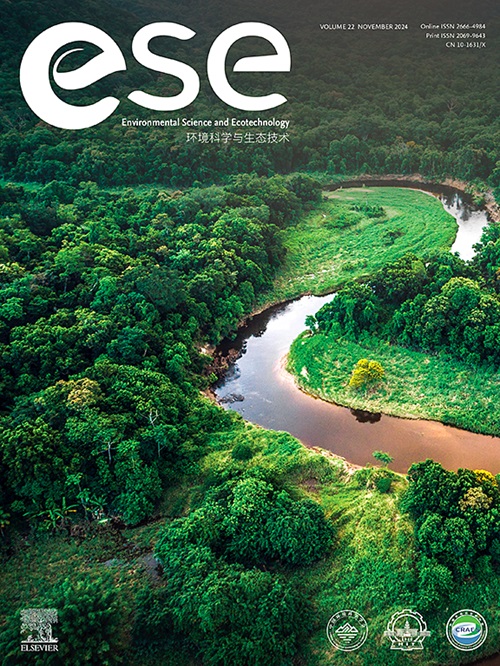Biocides as drivers of antibiotic resistance: A critical review of environmental implications and public health risks
IF 14.3
1区 环境科学与生态学
Q1 ENVIRONMENTAL SCIENCES
引用次数: 0
Abstract
The widespread and indiscriminate use of biocides poses significant threats to global health, socioeconomic development, and environmental sustainability by accelerating antibiotic resistance. Bacterial resistance development is highly complex and influenced significantly by environmental factors. Increased biocide usage in households, agriculture, livestock farming, industrial settings, and hospitals produces persistent chemical residues that pollute soil and aquatic environments. Such contaminants contribute to the selection and proliferation of resistant bacteria and antimicrobial resistance genes (ARGs), facilitating their dissemination among humans, animals, and ecosystems. In this review, we conduct a critical assessment of four significant issues pertaining to this topic. Specifically, (i) the role of biocides in exerting selective pressure within the environmental resistome, thereby promoting the proliferation of resistant microbial populations and contributing to the global spread of antimicrobial resistance genes (ARGs); (ii) the role of biocides in triggering transient phenotypic adaptations in bacteria, including efflux pump overexpression, membrane alterations, and reduced porin expression, which often result in cross-resistance to multiple antibiotics; (iii) the capacity of biocides to disrupt bacteria and make the genetic content accessible, releasing DNA into the environment that remains intact under certain conditions, facilitating horizontal gene transfer and the spread of resistance determinants; (iv) the capacity of biocides to disrupt bacterial cells, releasing intact DNA into the environment and enhancing horizontal gene transfer of resistance determinants; and (iv) the selective interactions between biocides and bacterial biofilms in the environment, strengthening biofilm cohesion, inducing resistance mechanisms, and creating reservoirs for resistant microorganisms and ARG dissemination. Collectively, this review highlights the critical environmental and public health implications of biocide use, emphasizing an urgent need for strategic interventions to mitigate their role in antibiotic resistance proliferation.

杀菌剂作为抗生素耐药性的驱动因素:对环境影响和公共卫生风险的批判性审查
杀菌剂的广泛和滥用加速了抗生素耐药性,对全球健康、社会经济发展和环境可持续性构成重大威胁。细菌耐药性的发展非常复杂,受环境因素的影响很大。在家庭、农业、畜牧业、工业环境和医院中越来越多地使用杀菌剂,产生持久性化学残留物,污染土壤和水生环境。这些污染物有助于耐药细菌和抗微生物药物耐药性基因(ARGs)的选择和增殖,促进它们在人类、动物和生态系统中传播。在这篇综述中,我们对与该主题有关的四个重要问题进行了批判性评估。具体而言,(i)杀菌剂在环境抗性组内施加选择压力的作用,从而促进耐药微生物种群的增殖,并促进抗微生物药物耐药性基因(ARGs)的全球传播;(ii)杀菌剂在触发细菌短暂表型适应中的作用,包括外排泵过表达、膜改变和孔蛋白表达减少,这通常导致对多种抗生素的交叉抗性;(iii)杀菌剂破坏细菌和使遗传内容可接近的能力,将DNA释放到在某些条件下保持完整的环境中,促进水平基因转移和抗性决定因素的传播;(iv)杀菌剂破坏细菌细胞的能力,将完整的DNA释放到环境中,并加强抗性决定因素的水平基因转移;(iv)杀菌剂与环境中细菌生物膜之间的选择性相互作用,加强生物膜凝聚力,诱导抗性机制,并为耐药微生物和ARG传播创造储存库。总的来说,这篇综述强调了使用杀菌剂对环境和公共卫生的重要影响,强调迫切需要采取战略性干预措施,以减轻其在抗生素耐药性扩散中的作用。
本文章由计算机程序翻译,如有差异,请以英文原文为准。
求助全文
约1分钟内获得全文
求助全文
来源期刊

Environmental Science and Ecotechnology
Multiple-
CiteScore
20.40
自引率
6.30%
发文量
11
审稿时长
18 days
期刊介绍:
Environmental Science & Ecotechnology (ESE) is an international, open-access journal publishing original research in environmental science, engineering, ecotechnology, and related fields. Authors publishing in ESE can immediately, permanently, and freely share their work. They have license options and retain copyright. Published by Elsevier, ESE is co-organized by the Chinese Society for Environmental Sciences, Harbin Institute of Technology, and the Chinese Research Academy of Environmental Sciences, under the supervision of the China Association for Science and Technology.
 求助内容:
求助内容: 应助结果提醒方式:
应助结果提醒方式:


